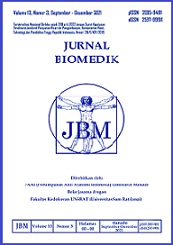CORRELATION BETWEEN ALLEN’S AND INVERSE ALLEN’S TESTS WITH DIAMETERS OF ULNAR AND RADIAL ARTERIES
DOI:
https://doi.org/10.35790/jbm.5.2.2013.2590Abstract
Abstrak: Arteri radialis semakin sering dipergunakan sebagai akses alternatif angiografi koroner dan intervensi karena dibanding akses femoralis, komplikasi perdarahan lebih rendah, mobilisasi lebih dini, dan biaya lebih murah. Terdapat beberapa hal yang dapat mengurangi keberhasilan prosedur ini; salah satunya ialah kegagalan pungsi karena ukuran a. radialis yang kecil. Studi sebelumnya menunjukkan bahwa uji Allen dapat digunakan untuk mendeteksi arteri dengan diameter yang lebih besar. Penelitian ini bertujuan untuk mengevaluasi apakah uji Allen dan inverse Allen berkorelasi dengan diameter a. ulnaris dan a. radialis. Penelitian ini berlangsung dari Juli hingga Desember 2012 di Laboratorium Kateterisasi Rumah Sakit Awal Bros Makassar. Pasien menjalani uji Allen dan inverse Allen sebelum prosedur. Ukuran diameter dalam dari lumen arteri radialis dan ulnaris diukur oleh operator dengan menggunakan analisis angiografi kuantitatif (operator tidak mengetahui hasil uji Allen). Uji Spearman’s rho digunakan untuk menganalisis korelasi antara uji Allen dan inverse Allen dengan diameter a. radialis dan a. ulnaris dengan P < 0,05 dianggap bermakna. Analisis statistik menggunakan SPSS versi 19. Hasil penelitian memperlihatkan 121 pasien (98 laki-laki dan 23 perempuan, rerata usia 57,5 (SD ± 11,9 tahun). Frekuensi crossover 3,3%. Uji Allen dan inverse Allen normal pada 116 pasien (95,8%). Rerata diameter a. radialis dan ulnaris ialah 2,14 (SD ± 0,34 mm) dan 1,95 (SD ± 0,45 mm). Uji korelasi Spearman’s rho menunjukkan korelasi bermakna antara uji Allen dan diameter a. ulnaris (P = 0,000; r = -0,485); uji inverse Allen dan diameter a. radialis (P = 0,015; r = -0,220). Simpulan: Terdapat korelasi bermakna antara uji Allen  dengan diameter a. ulnaris, dan uji inverse Allen dengan diameter a. radialis. Kedua uji ini sederhana dan dapat memberikan informasi tentang arteri mana memiliki diameter yang lebih besar. Bila uji Allen normal, maka a.ulnaris dapat dipergunakan sebagai akses alternatif ketika akses radialis gagal atau bahkan sebagai akses inisial jika uji inverse Allen abnormal atau waktu uji Allen lebih singkat dari inverse Allen, terutama untuk prosedur intervensi yang memerlukan arteri yang lebih besar sebagai akses.
Kata kunci: uji Allen, uji inverse Allen, diameter, arteri radial, arteri ulnaris.
Â
Â
Abstract: Radial artery has been increasingly used as an alternative site for coronary angiography and intervention because of its advantages over femoral access, such as: a reduction in bleeding complications, early mobilisation, and lower cost. Despite these advantages, there are some challenges that reduce procedural success. One of them is the puncture failure owing to the small vessel size. A previous study has demonstrated consistently that the Allen test may be used for detecting the artery with the largest diameter. This study aimed to evaluate whether the Allen’s and inverse Allen’s tests correlate to the diameters of ulnar and radial arteries. This study was conducted from July to December 2012 in the Catheterization Laboratory of Awal Bros Hospital Makassar. Patients underwent the Allen’s and inverse Allen’s test before the procedure. The inner luminal diameters of radial and ulnar arteries were measured by an operator using quantitative angiographic analysis software. The operator was blinded to the results of the Allen’s tests. The Pearson correlation test was used to analyze the correlation between Allen’s and inverse Allen’s test with the diameters of the radial and ulnar arteries. A P-value of < 0.05 was considered as statistically significant. Statistical analysis was performed with Statistical Package for Social Sciences (SPSS) version 19. The results showed that there were 121 patients (98 males and 23 females, the mean age being 57.5 (SD ± 11.9 years). The crossover rate was 3.3%. Both of the Allen’s and inverse Allen’s tests were normal in 116 patients (95.8%). By using a quantitative coronary analysis software, the mean diameters of the radial and the ulnar arteries were 2.14 (SD ± 0.34 mm) and 1.95 (SD ± 0.45 mm), respectively. The Spearman’s rho correlation test showed significant correlations between the Allen’s test and diameters of ulnar arteries (P = 0.000; r = -0.485), and between the inverse Allen’s test and diameters of radial arteries (P = 0.015; r = -0.220). Conclusion: The Allen’s test correlated to the diameters of the ulnar arteries and the inverse Allen’s test correlated to the diameters of the radial arteries. The normal Allen’s test indicated that the ulnar artery might be used as an alternative access site when the radial approach failed or even as an initial access if the inverse Allen’s test was abnormal or the Allen’s test was shorter than the inverse Allen’s test, especially for the intervention procedure which needed a larger artery as the access site. These tests are simple and may provide some important information about arteries with larger diameters. Future studies with larger series of patients will be necessary to confirm our results.
Keywords: Allen’s test, inverse Allen’s test, diameter, radial artery, ulnar artery.
Downloads
Issue
Section
License
Penyunting menerima sumbangan tulisan yang BELUM PERNAH diterbitkan dalam media lain. Naskah yang masuk dievaluasi dan disunting keseragaman format istilah dan cara penulisan sesuai dengan format penulisan yang terlampir dalam jurnal ini.
Segala isi dan permasalahan mengenai tulisan yang yang diterbitkan dalam jurnal menjadi tanggung jawab penuh dari penulis.







